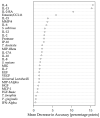Salivary Biomarkers for Dental Caries Detection and Personalized Monitoring
- PMID: 33806927
- PMCID: PMC8004821
- DOI: 10.3390/jpm11030235
Salivary Biomarkers for Dental Caries Detection and Personalized Monitoring
Abstract
This study investigated the potential of salivary bacterial and protein markers for evaluating the disease status in healthy individuals or patients with gingivitis or caries. Saliva samples from caries- and gingivitis-free individuals (n = 18), patients with gingivitis (n = 17), or patients with deep caries lesions (n = 38) were collected and analyzed for 44 candidate biomarkers (cytokines, chemokines, growth factors, matrix metalloproteinases, a metallopeptidase inhibitor, proteolytic enzymes, and selected oral bacteria). The resulting data were subjected to principal component analysis and used as a training set for random forest (RF) modeling. This computational analysis revealed four biomarkers (IL-4, IL-13, IL-2-RA, and eotaxin/CCL11) to be of high importance for the correct depiction of caries in 37 of 38 patients. The RF model was then used to classify 10 subjects (five caries-/gingivitis-free and five with caries), who were followed over a period of six months. The results were compared to the clinical assessments of dental specialists, revealing a high correlation between the RF prediction and the clinical classification. Due to the superior sensitivity of the RF model, there was a divergence in the prediction of two caries and four caries-/gingivitis-free subjects. These findings suggest IL-4, IL-13, IL-2-RA, and eotaxin/CCL11 as potential salivary biomarkers for identifying noninvasive caries. Furthermore, we suggest a potential association between JAK/STAT signaling and dental caries onset and progression.
Keywords: JAK; STAT; biomarkers; caries; diagnostics; interleukins; personalized monitoring; saliva; screening.
Conflict of interest statement
The authors declare no conflict of interest.
Figures








Similar articles
-
iTRAQ-based quantitative analysis of age-specific variations in salivary proteome of caries-susceptible individuals.J Transl Med. 2018 Oct 25;16(1):293. doi: 10.1186/s12967-018-1669-2. J Transl Med. 2018. PMID: 30359274 Free PMC article.
-
DENTINE CARIES: ACID-TOLERANT MICROORGANISMS AND ASPECTS ON COLLAGEN DEGRADATION.Swed Dent J Suppl. 2014;(233):9-94. Swed Dent J Suppl. 2014. PMID: 26688982
-
The relationship of dental calculus to caries, gingivitis, and selected salivary factors in 11- to 13-year-old children in Chiang Mai, Thailand.J Periodontol. 1998 Sep;69(9):955-61. doi: 10.1902/jop.1998.69.9.955. J Periodontol. 1998. PMID: 9776022
-
Human salivary proteins and their peptidomimetics: Values of function, early diagnosis, and therapeutic potential in combating dental caries.Arch Oral Biol. 2019 Mar;99:31-42. doi: 10.1016/j.archoralbio.2018.12.009. Epub 2018 Dec 24. Arch Oral Biol. 2019. PMID: 30599395 Review.
-
Salivary biomarkers for dental caries.Periodontol 2000. 2016 Feb;70(1):128-41. doi: 10.1111/prd.12100. Periodontol 2000. 2016. PMID: 26662487 Review.
Cited by
-
High-Throughput Sequencing Analysis of the Changes in the Salivary Microbiota of Hungarian Young and Adult Subpopulation by an Anthocyanin Chewing Gum and Toothbrush Change.Dent J (Basel). 2023 Feb 8;11(2):44. doi: 10.3390/dj11020044. Dent J (Basel). 2023. PMID: 36826189 Free PMC article.
-
Effects of Nystatin oral rinse on oral Candida species and Streptococcus mutans among healthy adults.Clin Oral Investig. 2023 Jul;27(7):3557-3568. doi: 10.1007/s00784-023-04969-5. Epub 2023 Mar 24. Clin Oral Investig. 2023. PMID: 36964224 Free PMC article.
-
OralDisk: A Chair-Side Compatible Molecular Platform Using Whole Saliva for Monitoring Oral Health at the Dental Practice.Biosensors (Basel). 2021 Oct 28;11(11):423. doi: 10.3390/bios11110423. Biosensors (Basel). 2021. PMID: 34821641 Free PMC article.
-
Clinical laboratory diagnostics in dentistry: Application of microbiological methods.Front Oral Health. 2022 Sep 8;3:983991. doi: 10.3389/froh.2022.983991. eCollection 2022. Front Oral Health. 2022. PMID: 36160119 Free PMC article. Review.
-
Evaluation of possible biomarkers for caries risk in children 6 to 12 years of age.J Oral Microbiol. 2021 Aug 17;13(1):1956219. doi: 10.1080/20002297.2021.1956219. eCollection 2021. J Oral Microbiol. 2021. PMID: 34434531 Free PMC article.
References
-
- Sanz M., Beighton D.A., Curtis M., Cury J.A., Dige I., Dommisch H., Ellwood R., Giacaman R.A., Herrera D., Herzberg M.C., et al. Role of microbial biofilms in the maintenance of oral health and in the development of dental caries and periodontal diseases. Consensus report of group 1 of the Joint EFP/ORCA workshop on the boundaries between caries and periodontal disease. J. Clin. Periodontol. 2017;44:S5–S11. doi: 10.1111/jcpe.12682. - DOI - PubMed
Grants and funding
LinkOut - more resources
Full Text Sources
Other Literature Sources

